Hino Ranger
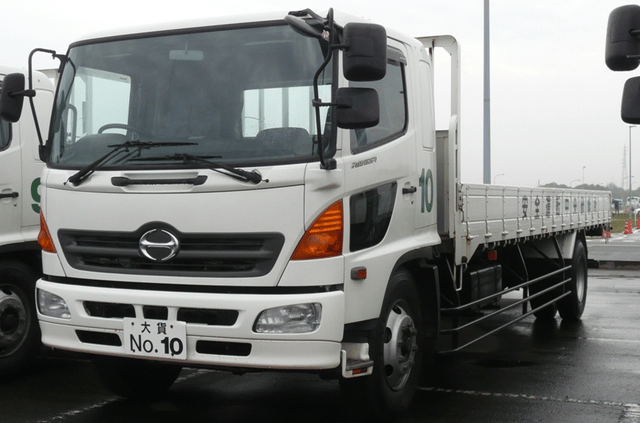
Hino Ranger

| Hino Ranger Hino 500 Series | |
|---|---|
| Overview | |
| Manufacturer | Hino Motors Kia Motors (South Korea) Kuozui Motors (Taiwan) Hino Motor Manufacturing Colombia (Colombia) PT Hino Motors Manufacturing Indonesia (Indonesia) |
| Also called | Hino 500 Series Hino Validus Ford N-Series Kia Rhino |
| Production | 1964-present |
| Assembly | Japan |
| Body and chassis | |
| Class | Truck |
| Body style | Truck (standard cab (Worldwide), crew cab (Australia only)) |
| Powertrain | |
| Transmission | Hino (manual) Allison (automatic) |
The Hino Ranger (Japanese: 日野レンジャー) is a medium-duty commercial vehicle produced by Hino Motors, a 50.1% subsidiary of Toyota Motor Corporation. It was originally introduced in 1964. There has also been a partial divergence into a heavier and a lighter range, with the smaller Rangers distinguished by various add-ons such as "Day Cab Ranger"
The Ranger is part of Hino's F-Series Truck with model code such as FC, FD, FE, FF, FG, FL, and FM. The further the alphabet means the higher payload. The 4WD models are FT and GT. The SG is Tractor Head to pull container. In certain countries, the Ranger is only available as medium or heavy truck, while the small or low payload models like FA and FB were replaced by Hino Dutro. In Japan, the small Ranger FA was rebadged as Toyota Dyna.
Hino has competed in the Dakar Rally in 1991, with the Ranger FT 4WD truck driven by Yoshimasa Sugawara, a Japanese rally driver. He always finished in the Top 10 in Camion Category. For 17 straight years, Hino always won the under 10,000 cc class, and captured 1st overall in the 1997 event.
| Hino Ranger Hino 500 Series | |
|---|---|
| Overview | |
| Manufacturer | Hino Motors Kia Motors (South Korea) Kuozui Motors (Taiwan) Hino Motor Manufacturing Colombia (Colombia) PT Hino Motors Manufacturing Indonesia (Indonesia) |
| Also called | Hino 500 Series Hino Validus Ford N-Series Kia Rhino |
| Production | 1964-present |
| Assembly | Japan |
| Body and chassis | |
| Class | Truck |
| Body style | Truck (standard cab (Worldwide), crew cab (Australia only)) |
| Powertrain | |
| Transmission | Hino (manual) Allison (automatic) |
1st Generation (1964-1983)
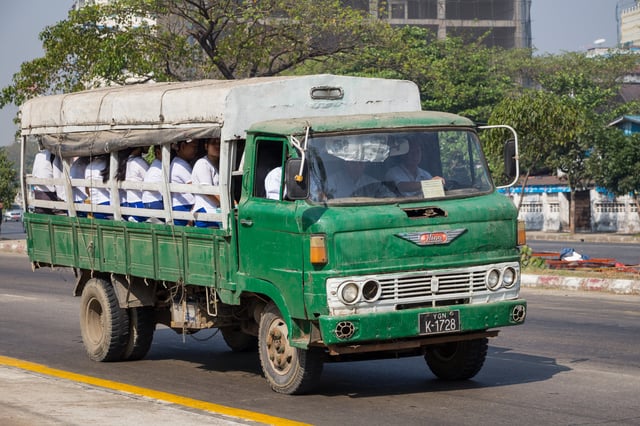
First generation Hino Ranger (second facelift model)
The first Hino Ranger appeared as the 3.5-tonne Ranger KM300 in June 1964, landing in Japan's newly competitive middleweight truck category.[1] There was also a short wheelbase model called the KM320. The long-wheelbase KM340 appeared in December, and the cabin became a three-seater (rather than two) in 1966. The first model had a body-colored grille and separate headlamp surrounds; this was changed with a facelift in November 1967, when the headlights were integrated into the grille. Until they were changed in 1968, the Ranger had suicide doors. In November 1969 the design was changed again, now with twin headlamps in a grille painted a contrasting colour. More importantly, the cab was made 55 mm (2.2 in) longer, improving comfort. The Ranger KM was not a very strong seller, being limited to 3,500 kg (7,700 lb) cargo capacity while the licensing system favored 4-tonne trucks.[1]
The original engine produced 90 PS (66 kW). Along with the 1967 facelift came ten extra horsepower, although the six-cylinder DM100 unit still displaced 4,313 cc (263.2 cu in).[2] In April 1971 the wheelbases were changed across the range, meaning new model numbers: KM310 (regular), KM330 (short), and KM350 (long).[3] In April 1978 the engine was upgraded and various safety improvements (high-backed seats, larger rear view mirrors) were introduced. The new engine was the 4,507 cc (275.0 cu in) DQ100 and output increased to 110 PS (81 kW). The line was now designated KM500, with the short wheelbase (usually sold as a dump truck) called the KM520 and the long wheelbase model called the KM540.[4]
In 1978 the 2-tonne Hino Ranger 2 appeared, a rebadged Toyota Dyna (also sold as the Daihatsu Delta) with Daihatsu or Toyota engines. This then spawned a 3-tonne version, called the Ranger 3. By late 1979 the Ranger KM received a name change, too, becoming the Hino Ranger 3M. This also met the latest (1979) emissions regulations. When the emissions were tightened again in 1983, the Ranger 3M received its last modifications to meet them and was now equipped with a chrome-bordered grille. In 1984, production of the KM ended as it was replaced by the Day Cab Ranger.[1]
2nd Generation (1969-1980)
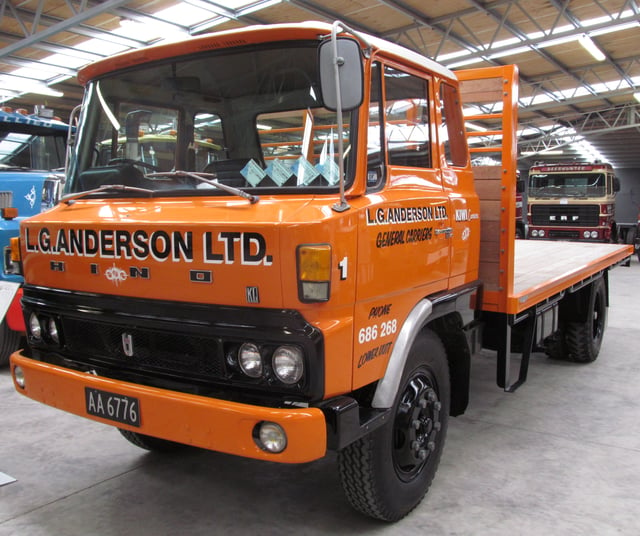
Hino KL340
The Hino Ranger KL was introduced in Japan in 1969. After the 1979 discontinuation of the Toyota Massy Dyna, the Ranger series replaced that truck. In Australia, it was sold as Toyota KL300. The Ranger KL-series were offered as short wheelbase KL300, medium wheelbase KL340 and KL350, as well as long wheelbase KL360 and KL380. The Ranger line-up spawned into KB, KR, KQ, and other models. Engines are 4.5 liter DQ100 and 5.0 liter EC100.
3rd Generation (1980-1989)
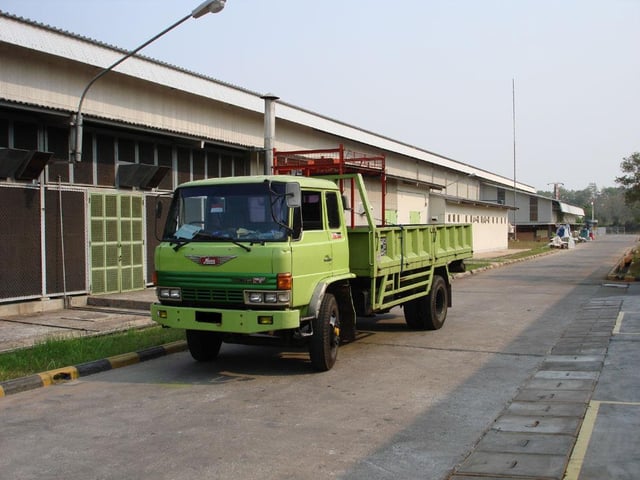
Hino Ranger FF173, facelift design
Introduced in Japan in 1980, early models (marketed as Wind Ranger in Japan) have twin round headlights, while facelift models (marketed as Ranger +5 and ONE UP Ranger +5 in Japan) come with slimmer rectangular units. The engine range was also updated. The cab design was inspired by European trucks and was considerably more aerodynamic than its predecessor; 35 percent more so according to Hino themselves. The cab was built by robots.[5]
From 1982, Ford Motor Company and Hino signed a deal for badge-engineered trucks to be known as the Ford N series for release in the Australian and New Zealand markets to replace the Ford D series trucks. The deal lasted 15 years.
From 1988 to 1998, the third generation Ranger was manufactured under license by Kia Motors and sold as the first generation Kia Rhino in South Korea.
The third generation Ranger was the first Hino model sold in the United States with the first variants FE17, FE19, FF17, FF19, FG19 and FG22 introduced in 1983 for the 1984 model year.[6] In North America, the Ranger name was not used and all trucks were sold under their model numbers. Production of the third generation for the North American market ended in 1992 when it was replaced by the fourth generation.
Japanese model production began tapering off in 1989 (export models and special use versions continued to be manufactured until 1992 at least), while Indonesian models lasted until 2003.
- Indonesia
Models in Indonesia are FF172, FF173, FL176, FM226, and SG221. The FF and SG were marketed as Super Ranger, the FL and FM are Jumbo Ranger. The well equipped FF Super Ranger was introduced in late 1985 and offered features such as dual circuit power brakes, a tilt steering wheel, and a 175 PS (129 kW) diesel engine.[7]
Day Cab Ranger (1984-1995)
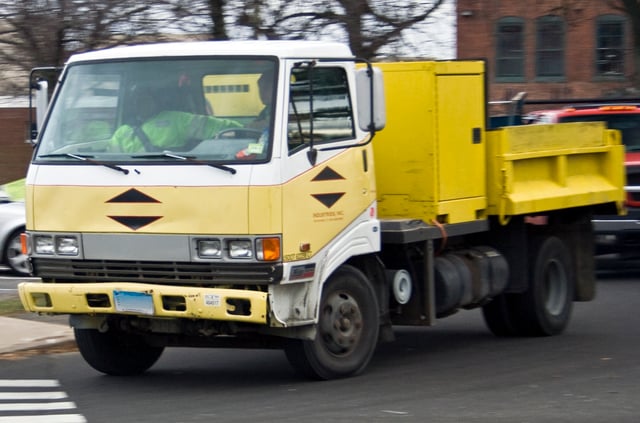
Hino Day Cab Ranger (original version)
The original KM-series Ranger was finally discontinued as the new, light medium Day Cab Ranger appeared in June 1984. Unlike competitors from other manufacturers, who used cabs from their light truck production, the Day Cab Ranger was a dedicated design. It was available as a 3.5-tonner ("3B") or a 4.5-tonner ("4C"). The available engines were all diesels: the 4,009 cc (244.6 cu in) W04D four-cylinder, the W06D six-cylinder with 5,759 cc (351.4 cu in), or the 6,728 cc (410.6 cu in) H07C for heavier-duty applications.[8] Outputs were 115 PS (85 kW) for the four-cylinder, 145 and 175 PS (107 and 129 kW) for the sixes. In November 1988 the Day Cab Ranger was facelifted, receiving a new, smoother grille.
In May 1990 the Day Cab Ranger received a thorough facelift, with new glazed doors and a new front treatment. The engines now met the 1989 emissions standards. The W04D remained, although output was increased to 120 PS (88 kW), while the W06D was replaced by the 6,014 cc (367.0 cu in) W06E with 165 PS (121 kW) and the H07C was replaced by the 7,412 cc (452.3 cu in) H07D with 195 PS (143 kW). The 3B and 4C names were dropped and they were now mainly referred to as Ranger FB and Ranger FC. In 1995 it was replaced by the lighter versions of the (fourth generation) "Rising Ranger" although production continued for North America until the end of model year 1997.
1984 also marked the appearance of the second generation Ranger 2/3, a series of two- and three-tonne trucks which were actually rebadged Toyota Dynas.
In the Top Gear Burma Special James May drove a Day Cab Ranger (FB110) with a crane attachment.
4th Generation (1989-2002)
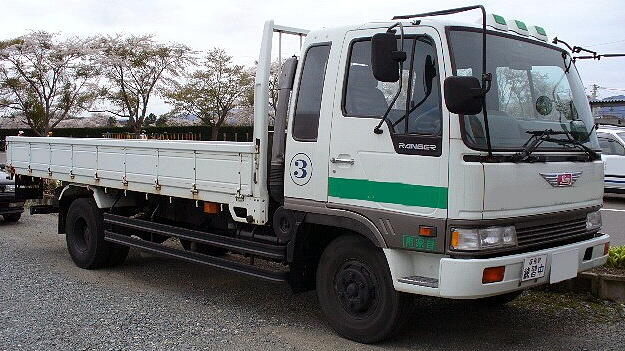
Pre-facelift model Hino Cruising Ranger in Japan
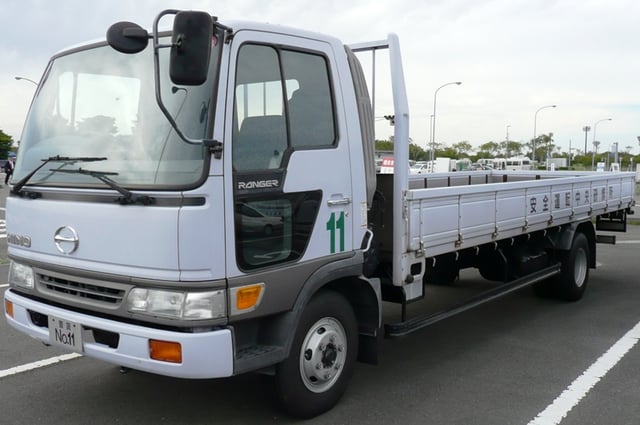
First facelift model Hino Rising Ranger in Japan

Second facelift model Hino Space Ranger in Japan
In Japan, this generation was introduced in 1989 and marketed as Cruising Ranger, then Rising Ranger and Space Ranger following each of its two facelifts in 1994 and 1999, respectively. The lightweight models, introduced in 1995 as part of the Rising Ranger line, replaced the earlier "Day Cab Ranger" as all models were unified.
Light Truck : FA, FB
Light Medium Truck : FC, FD, FE, GD
Medium Heavy Truck 4x2 : FF, FG
Medium Truck 4x4 : FT, GT, GX
Tractor Head : SG
Hino entered three Ranger FTs in the 1997 Dakar Rally, and results were 1-2-3 Overall in the Camion (Truck) Category.
In North America, Hino continued using model numbers instead of the Ranger name for its medium truck. Introduced in 1992 for the 1993 model year, the initial models were FD2218, FD2218LP, FE2618, FF3018, FF3020, SG3320, SG3323 and SG3325.[9] The lineup was refreshed in 1997 for the 1998 model year with a minor facelift, new engines, new gross vehicle weight ratings and new light-duty models FA1517 and FB1817. The refreshed medium-duty and medium-heavy lineup consisted of FF2220, FD2320, FE2620, FF3020, SG3320, and SG3325.[10] The first two digits indicate the Gross Vehicle Weight Rating (GVWR), and the last two digits refer to engine power. FA1517 means the smallest truck with 15,000 lbs GVWR, and around 170 bhp. The fourth generation was the last generation of Ranger sold in North America, replaced by the 600 series following its discontinuation after model year 2004.
Japanese model production began tapering off in 2002 (export models and special use versions continued to be manufactured until 2004 at least).
The fourth generation Hino Ranger was not sold in Indonesia, since the third generation was manufactured locally until 2003. From 1998 to 2003, the fourth generation Ranger was manufactured under license by Kia Motors and sold as the second generation Kia Rhino in South Korea.
5th Generation (2001-2017)
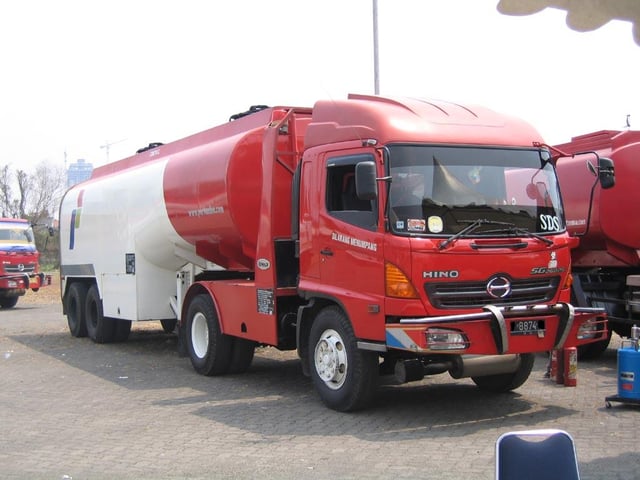
Hino Super Ranger SG260J
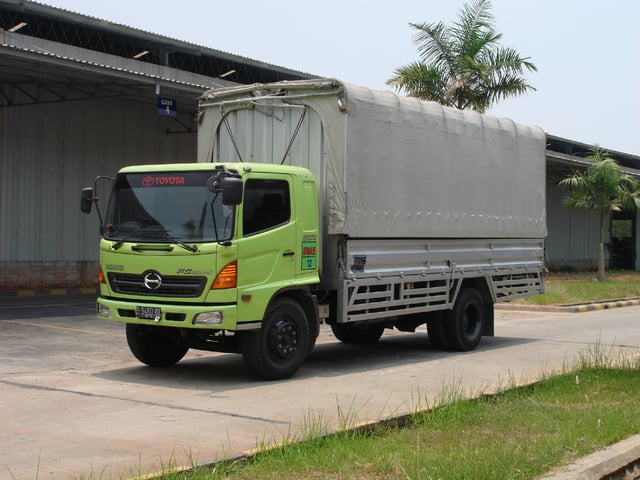
Hino 500 FG210J Wing in plant in Indonesia
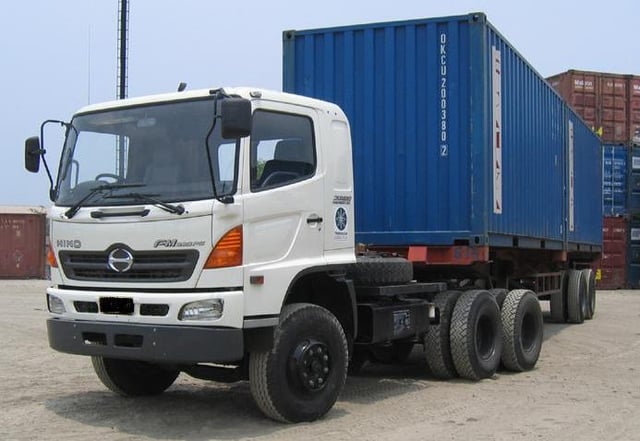
Hino Jumbo Ranger FM320P
Marketed in Japan as Ranger Pro, or Hino 500 Series for export. In Indonesia, Super Ranger and Jumbo Ranger names used on the locally-produced third-generation model it replaced. In Malaysia, it is called Validus. The Ranger series is marketed as the Hino Mega in Thailand. The light-duty fourth-generation FA and FB models sold in some markets were discontinued with this generation and replaced by the 300 Series or light-duty versions of the 600 Series.
The Ranger is available with combination of various cabin, standard or wide, standard roof or high roof, short cab or full cab. The FD is also available as Double Cab.
A High Grade Package with chrome bumper, discharge headlights, wood panel, and other interior upgrades is offered in the Japanese Domestic Market.
Light Medium Truck : FC, FD, GD, FE
Medium Heavy Truck 4x2 : FF, FG, FJ
Medium Truck 4x4 : FT, FX, GT, GX
Medium Heavy Truck 6x2: FL
Medium Heavy Truck 6x4: GK, FM
Medium Heavy Truck 8x4: GY
Tractor Head 4x2: SG
Tractor Head 6x2: SG
Tractor Head 6x4: FM
Hino is the market leader for truck and bus in Indonesia since 2000. The current best selling model is Jumbo Ranger FM260J D. This dump truck is commonly used for construction and coal mining.
A diesel hybrid-electric version is also available in Japan.
6th Generation (2015-present)
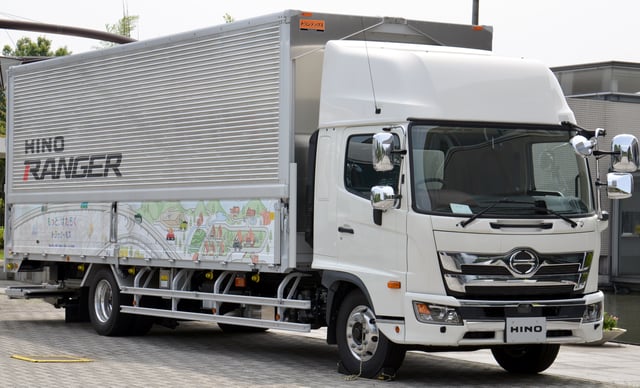
Facelift model Hino Ranger FE in Japan
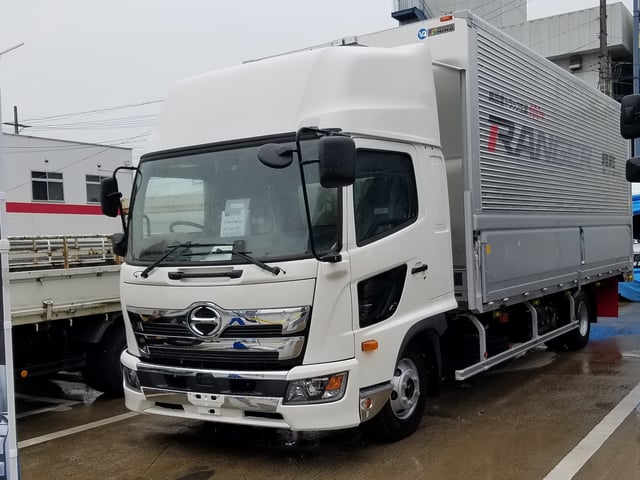
2017 Hino Ranger FD cargo truck
Some minor changes were introduced in January 15, 2015. The New Hino Ranger Series now has a new look with a refreshed upside-down trapezoidal shape front grill with dark grey color, new headlamp, semi-floating suspension, and revised chassis. Besides that, there is a minor upgrade on the axles - all of the New Hino Ranger Series now uses 10 wheel studs instead of the usually found 8 wheel studs in previous generations. This 10-wheel-stud design is not new to Hino because some heavy-duty series Hino Ranger, usually the cement mixer version, had already used this design several years before. However, since 2015, the 10-wheel-stud design is now a standard feature for all Hino Ranger Series.
In April 2017, this facelifted version was revealed along with the facelifted Profia. It incorporates new generation trapezoidal shape grill, a bigger high roof, LED headlights, a revised dashboard, a new four-spoke steering wheel replacing the original two-spoke design, a configurable instrument cluster and a premium interior. The new Ranger mid-cycle update also debuts the all-new 5.1-liter A05C engine that replaces both J05E and J08E engines. Transmissions should continue to with manual (6-speed or 7-speed), Allison automatic (6-speed) and Pro Shift semi automatic (6-speed or 7-speed). Sales began in Japan later in 2017.
Engines
| Diesel engines | |||
|---|---|---|---|
| Engine [Model] | Production [Year] | Displacement | Cylinder |
| J05E | Until 2017 | 5,123 cc (312.6 cu in) | I4 |
| A05C | 2017 onwards | 5,123 cc (312.6 cu in) | I4 |
| J08E (Export only) | 7,684 cc (468.9 cu in) | I6 | |
| A09C (Export only) | 8,866 cc (541.0 cu in) | I6 | |
See also
List of hybrid vehicles